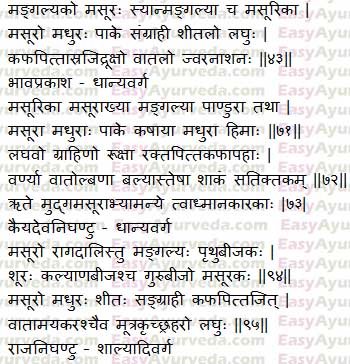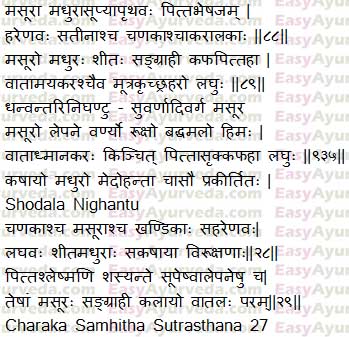Lentils (Masoor) – Uses, Medicinal Qualities, Remedies, Research
By Dr Renita D’Souza
In Ayurveda, Lentils are one among the shimbi dhanya (group of legumes and pulses) and known as Masura dhanya. Lentils are nutritious and widely used in culinary purposes. It is also used as medicine in the form of soup and ointment. Masura improves skin complexion and it is included complexion promoting paste (raktha chandanadi lepa).
Table of Contents
Introduction
It is a wholesome diet in disease conditions like vomiting, dysentery, piles, jaundice, herpes, blisters, PCOD etc. It is also used externally for application in diseases like gout (vataraktha), chronic wound, herpes etc, along with other medicinal herbs.
Read – Barley (Hordeum vulgare) – Qualities, Uses, Remedies, Research
The diseases condition in Ayurveda known as Masurika is compared to small pox and its variant laghu masurika to chicken pox. The shapes of blisters in these conditions are similar to masura or lentils.
Botanical Name – Lens culinaris
Synonyms – Lens esculenta, Ervum lens
Family – Leguminosae
Vernacular names
Names in Different Languages
English Name – Lentil
Sanskrit Name – Masura
Hindi Name – Masur, Masurak, Masuri, Masoor, Masoor Dal
Marathi Name – Masur
Bengali Name – Masuri
Gujarati Name – Masur
Kannada Name – Chanagi
Tamil Name – Misur
Telugu Name – Masur pappu
Spanish Name – lenteja
French – lentille
Portuguese – lentilha
Germany Name – Linse
Italy – lenticchia
Netherlands – linze
Sweden – lins
Read – Green Gram (Mung bean) Qualities, Uses, Remedies, Research
Sanskrit Verse


Masoor Qualities, Uses, Remedies
Medicinal Qualities of Masura
Taste – Sweet, astringent
Vipaka (taste conversion after digestion) – Sweet
Grahi – absorbent
Potency (virya) – cold (shita)
Laghu – light to digest
Ruksha – dry in nature
Varnya – improves skin complexion
Balya – improves strength
Aadmanakara – causes bloating
Effect on Tridosha
Vatala – increases vata dosha
Balances kapha and pitta dosha
Therapeutic uses of Lentils
Raktapitta – bleeding disorders
Jwara – fever
Mutrakrchra – difficulty and painful urination
Read – Ayurveda Mahodadhi: Legumes Green Gram, Chickpea, Peas
Traditional Health Remedies of Masoora
- Diarrhea and Dysentery – soup of lentils processed with panchakola (Long pepper, root of long pepper, Piper retrofractum, Plumbago zeylanica and Ginger) is beneficial.
- Dysentery – juice or decoction of red lentils is a wholesome diet.
- Vomiting
Mudgadi sattu – refreshing drink prepared from mixing flours of green gram, lentils, Bengal gram and peanut mixed with powder of ginger and honey is used in vomiting of kapha origin.
Linctus prepared with the powder of the roasted green gram, red lentil, bengal gram and peanut mixed with the powder of Ginger and honey is also useful in kaphaja type of vomiting. - Bleeding piles – to stop bleeding, lentil soup mixed with sour buttermilk is useful.
- Herpes (visarpa) – Paste of lentils mixed with ghee and applied externally. It is also good to include lentil soup (masura yusha) in the diet.
- Ulcers –
For the treatment abscesses wound having a fine opening, and expanded base, Pidana (compression) therapy is administered.
Application of the paste of pea, lentils, wheat and Harenu without the addition of any fat is immensely helpful in compression therapy. [Charaka Chikitsa 25/61 – 62] - Blisters – Soup made from green gram, lentils and Pigeon pea mixed with ginger powder is beneficial in blisters.
Read – Daal – Soup Of Pulses – Preparation Method, Health Benefits
Interaction with medicines, supplements
Can this be used while taking Homeopathic medicine?
Yes. This product does not react with homeopathic medicine.
Can
this medicine be continued while taking supplements like multivitamin tablets,
Omega 3 fatty acids etc?
Yes. Generally, this product goes well with most
of the dietary supplements. However, if you are taking more than one product
per day, please consult your doctor for an opinion.
With western
medicines
Seek your
doctor’s advice if you are taking this product along with other western
(allopathic / modern) medicines. Some Ayurvedic herbs can interact with modern
medicine.
If both Ayurvedic and allopathic medicines are advised together, then it is
best to take Allopathic medicine first, wait for 30 minutes and then take the
Ayurvedic medicine.
Chemistry, Nutrients, Research
Chemical components of lentils
Lentils contain phenolics, condensed tannins, carotenoids, toco-pherols, saponins, phytic acid, and phytosterols.
Nutritional components of Lentils
Lentils are a rich source calories, carbohydrates including dietary fiber, protein, fat and numerous essential nutrients including folate, manganese, thiamin, potassium, pantothenic acid, vitamin B6, phosphorus, iron, and zinc. They containcarotenoids, lutein and zeaxanthin, and polyunsaturated fatty acids.
(read more)
Research
Research study done to investigate chemopreventive effect of raw and cooked lentils (Lens culinaris L) and soybeans (Glycine max) against azoxymethane-induced aberrant crypt foci have concluded that consumption of lentils protect against colon cancer.(A)
Morphology, Distribution
Morphology of Masoor
Lens culinaris is an annual herbaceous plant grows up to 40 cm in height.
Distribution
Lens culinaris is cultivated in India, Canada, Australia, southern Europe, Africa and the dry areas of the Middle East.
Ayurvedic Medicines
Ayurvedic medicines with Masura as Ingredient
Trayantadi Kashayam – used in the Ayurvedic treatment of skin diseases, abscess, burning sensation, fever, vomiting, bleeding diseases and liver diseases.
Mukhadooshikari Lepam – used to treat pimples and acne. It cleanses facial skin, improves skin complexion and texture.
Sanskrit Synonyms
Sanskrit Synonyms
Mangalyaka, Masoora, Mangalya, Masoorika
Pandura
Side effects, Categorization,
Lentils (masoora) as Unwholesome diet
Continuous intake of lentil can cause vata related diseases. In some diseases Lentils are considered as unwholesome diet. Examples –
- Low back pain
- Fever of recent origin
- Asthma
- Sciatica
Classical Categorization
Bhavaprakasha Nighantu – Dhaanya varga
Kaiyadeva Nighantu – Dhaanya varga
Raja Nighantu – Shalyaadi varga
Dhanvantari Nighantu – Suvarnaadi varga
Shodala Nighantu – Shimbidhanya varga
Botanical Classification
Domain – Eukaryota
Kingdom – Plantae
Phylum – Spermatophyta
Subphylum – Angiospermae
Class – Dicotyledonae
Order – Fabales
Family – Fabaceae
Subfamily – Papilionoideae
Genus – Lens
Species – Lens culinaris subsp. culinaris
Lentils, sprouted, raw
मधुरा रूक्षाः कषायाः कटुपाकिनः | वातलाः कफपित्तघ्ना बद्धमूत्रमला हिमाः ||२८|| ऋते मुद्गमसूराभ्यामन्ये त्वाध्मानकारकाः |(madanapala nighantu)
Taste
– sweet, astringent
Properties – dry
Potency – cold
After digestion taste transformation ( Vipaka ) – pungent
Effect on Doshas
Vata increasing
Pitta balancing
Kapha balancing
Click to Consult Dr Renita D’Souza









